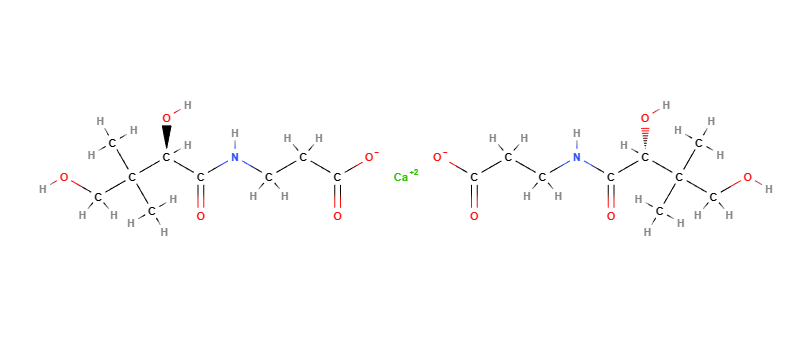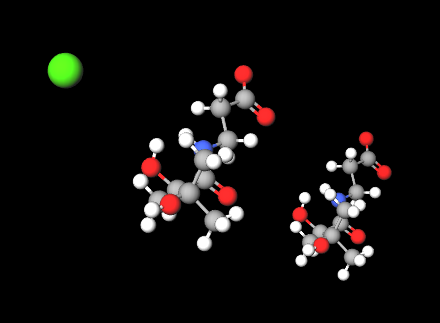| "Descrizione" by FRanier (9971 pt) | 2023-Dec-02 18:37 |
Review Consensus: 9 Rating: 9 Number of users: 1
| Evaluation | N. Experts | Evaluation | N. Experts |
|---|---|---|---|
| 1 | 6 | ||
| 2 | 7 | ||
| 3 | 8 | ||
| 4 | 9 | ||
| 5 | 10 |
Calcium D-pantothenate is a chemical component composed of pantothenic acid (Vitamin B5) and calcium salt. The inclusion of calcium salt is necessary because the free acid is, by its nature, hygroscopic and unstable.
The name defines the structure of the molecule:
- "Calcium" refers to the calcium ion, which is a divalent cation.
- "D-pantothenate" refers to the saline form of pantothenic acid, also known as vitamin B5.
- "D" refers to the specific optical isomer of pantothenic acid that is biologically active.
Description of the raw materials used in its production:
- Pantothenic Acid - Pantothenic acid is a vitamin belonging to the B complex. It is naturally found in many foods such as meat, eggs, whole grains, and leafy greens. It is extracted from these sources or chemically synthesized to produce calcium D-pantothenate.
- Calcium - Calcium is an essential mineral for bone and teeth health. In calcium D-pantothenate, pantothenic acid is bound to calcium to enhance its stability and bioavailability.
The synthesis process takes place in different steps:
- Preparation of pantothenic acid. Pantothenic acid is synthesised from isobutyraldehyde and formaldehyde in the presence of a catalyst.
- Formation of the calcium salt. Pantothenic acid is reacted with calcium hydroxide to form the calcium salt, D-pantothenate.
It appears in the form of a white powder.

What it is for and where
Calcium D-pantothenate has an antioxidant action due to the presence of pantothenic acid.
Medical
Studies
Wound healing
- Wound healing is a complex process involving interactions among a variety of different cell types. The normal wound repair process consists of three phases--inflammation, proliferation, and remodeling that occur in a predictable series of cellular and biochemical events. Applications of some drugs (antioxidants--asiaticoside, vitamin E and ascorbic acid; calcium D-pantothenate, exogenous fibronectin; antileprosy drugs--oil of hydnocarpus; alcoholic extract of yeast) accelerate wound healing (1).
Ultraviolet radiation
- Ultraviolet radiation (UVR) is known to be harmful to normal human epidermal keratinocytes (NHEKs) of the epidermal skin layer, as well as to hair-follicle-associated keratinocytes. An oral formulation containing l-cystine, thiamin, calcium d-pantothenate, medicinal yeast, keratin and p-aminobenzoic acid (Panto[vi]gar®) has demonstrated clinical efficacy for the treatment of diffuse telogen effluvium; however, its mode of action at the cellular level, and in particular whether protective mechanisms are involved, has yet to be elucidated (2).
Patulin
- Thiamine hydrochloride, pyridoxine hydrochloride and calcium-d-pantothenate were applied apple juice concentrates (AJC) at various doses in order to reduce the patulin content. AJC samples containing high levels of patulin were stored at 22 +/- 2 degrees C and 4 degrees C for 6 months after vitamins were added. Patulin was fully degraded at the end of a 6-month period in samples stored at 22 +/- 2 degrees C, on the other hand, other quality parameters diminished significantly. Without any considerable reduction on other quality parameters, applications of 1000 and 2500 mg/kg calcium-d-pantothenate resulted in reduction of patulin of 73.6 and 94.3%, respectively, however, 42.1% of patulin reduction was observed in the control sample of AJC stored for 1 month at 22 +/- 2 degrees C. Addition of thiamine hydrochloride (1000 mg/kg), pyrodoxine hydrochloride (625 or 875 mg/kg) and calcium-d-pantothenate (1000 or 2500 mg/kg) into the samples and storage at 4 degrees C for 6 months yielded 55.5 to 67.7% of patulin reduction which was only 35.8% for the control while the other quality parameters were protected adequately (3).
Cosmetics
Calcium Pantothenate can be found in cosmetic products, which acts as follows INCI:
Skin conditioning agent - Miscellaneous. This ingredient has the task of modifying and improving the condition of the skin when it is damaged or dry, reducing flaking and restoring its elasticity.
Hair conditioning agent. A significant number of ingredients with specific and targeted purposes may co-exist in hair shampoo formulations: cleansers, conditioners, thickeners, matting agents, sequestering agents, fragrances, preservatives, special additives. However, the indispensable ingredients are the cleansers and conditioners as they are necessary and sufficient for hair cleansing and manageability. The others act as commercial and non-essential auxiliaries such as: appearance, fragrance, colouring, etc. Hair conditioning agents have the task of increasing shine, manageability and volume, and reducing static electricity, especially after treatments such as colouring, ironing, waving, drying and brushing. They are, in practice, dispersants that may contain cationic surfactants, thickeners, emollients, polymers. The typology of hair conditioning agents includes: intensive conditioners, instant conditioners, thickening conditioners, drying conditioners. They can perform their task generally accompanied by other different ingredients.
Commercial Applications
Dietary supplements. Used as a source of vitamin B5 in nutritional supplements.
Food fortification. Added to foods as a vitamin B5 source.
Cosmetics. Often incorporated in hair and skin care products, as vitamin B5 is believed to have moisturizing properties.
Pharmaceutical products. May be used in certain pharmaceutical formulations that require vitamin B5.
Medical Applications
Treatment of vitamin B5 deficiencies. Used to treat or prevent pantothenate deficiency.
(Note: As with all vitamins and additives, the use of Calcium D-pantothenate should be in line with recommended daily allowances and regulatory guidelines recommended by your doctor).
 |  |
- Molecular Formula C18H32CaN2O10
- Peso molecolare 476.536
- CAS 6381-62-0
- UNII 6IY177DF2V
- EC number 205-278-9
Synonyms:
L-Calcium pantothenate, Calcium D-pantothenate hydrate, Calcium dextro-antothenate, D-Pantothenic acid calcium salt hydrate, Calcium D-pantothenate hydrate, Calcium (+/-)-N-(2,4-dihydroxy-3,3-dimethyl-1-oxobutyl)-alaninate, beta-Alanine, N-((2S)-2,4-dihydroxy-3,3-dimethyl-1-oxobutyl)-, calcium salt (2:1)
References_________________________________________________________________________
(1) Komarcević A. The modern approach to wound treatment. Med Pregl. 2000 Jul-Aug;53(7-8):363-8. Review. Croatian.
Abstract. Introduction: Wound healing is a complex process involving interactions among a variety of different cell types. The normal wound repair process consists of three phases--inflammation, proliferation, and remodeling that occur in a predictable series of cellular and biochemical events. Wounds are classified according to various criteria: etiology, lasting, morphological characteristics, communications with solid or hollow organs, the degree of contamination. In the last few years many authors use the Color Code Concept, which classifies wounds as red, yellow and black wounds. This paper presents conventional methods of local wound treatment (mechanical cleansing, disinfection with antiseptic solutions, wound debridement--surgical, biological and autolytic; wound closure, topical antibiotic treatment, dressing), as well as general measures (sedation, antitetanous and antibiotic protection, preoperative evaluation and correction of malnutrition, vasoconstriction, hyperglycemia and steroid use, appropriate surgical technique, and postoperative prevention of vasoconstriction through pain relief, warming and adequate volume resuscitation).
(2) Hengl T, Herfert J, Soliman A, Schlinzig K, Trüeb RM, Abts HF. Cystine-thiamin-containing hair-growth formulation modulates the response to UV radiation in an in vitro model for growth-limiting conditions of human keratinocytes. J Photochem Photobiol B. 2018 Dec;189:318-325. doi: 10.1016/j.jphotobiol.2018.09.005. Epub 2018 Sep 17.
(3) Yazici S, Velioglu YS. Effect of thiamine hydrochloride, pyridoxine hydrochloride and calcium-d-pantothenate on the patulin content of apple juice concentrate. Nahrung. 2002 Aug;46(4):256-7. doi: 10.1002/1521-3803(20020701)46:4<256::AID-FOOD256>3.0.CO;2-A. PMID: 12224421.
Abstract. Thiamine hydrochloride, pyridoxine hydrochloride and calcium-d-pantothenate were applied apple juice concentrates (AJC) at various doses in order to reduce the patulin content. AJC samples containing high levels of patulin were stored at 22 +/- 2 degrees C and 4 degrees C for 6 months after vitamins were added. Patulin was fully degraded at the end of a 6-month period in samples stored at 22 +/- 2 degrees C, on the other hand, other quality parameters diminished significantly. Without any considerable reduction on other quality parameters, applications of 1000 and 2500 mg/kg calcium-d-pantothenate resulted in reduction of patulin of 73.6 and 94.3%, respectively, however, 42.1% of patulin reduction was observed in the control sample of AJC stored for 1 month at 22 +/- 2 degrees C. Addition of thiamine hydrochloride (1000 mg/kg), pyrodoxine hydrochloride (625 or 875 mg/kg) and calcium-d-pantothenate (1000 or 2500 mg/kg) into the samples and storage at 4 degrees C for 6 months yielded 55.5 to 67.7% of patulin reduction which was only 35.8% for the control while the other quality parameters were protected adequately.
| Evaluate |

